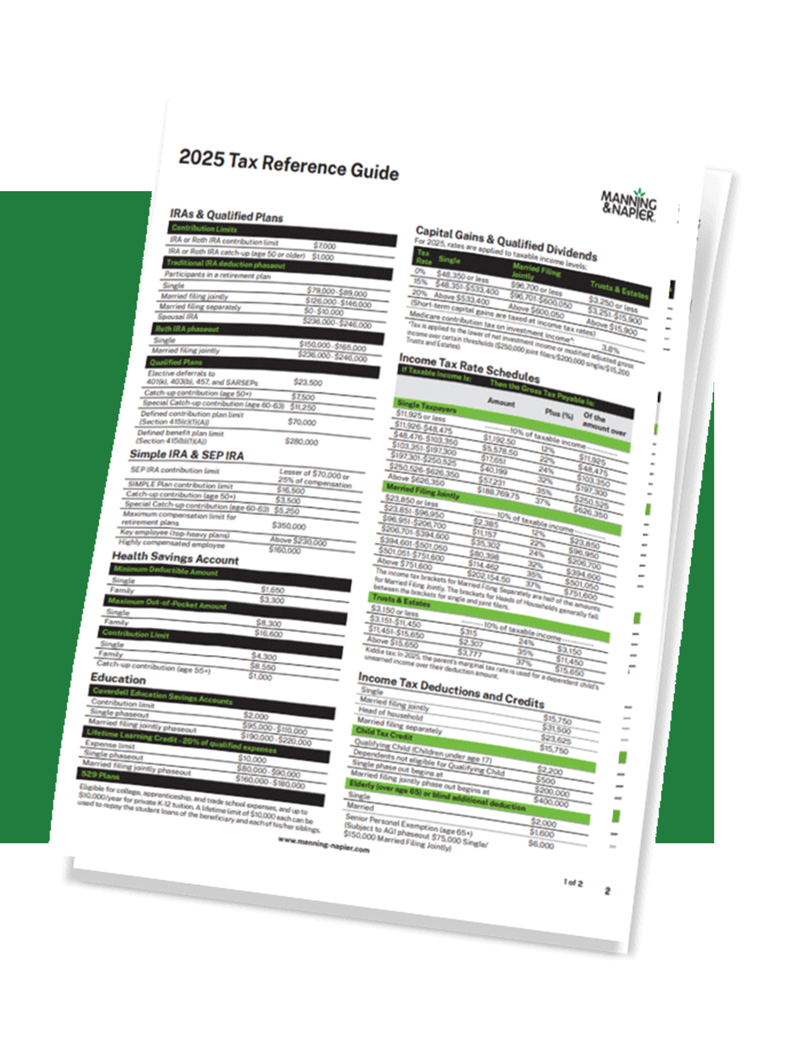The recently passed tax reform package, dubbed the One Big Beautiful Bill Act (OBBBA), marks a sweeping overhaul with far-reaching implications. With changes spanning income brackets, estate planning, capital gains, and pass-through entities, this legislation rewrites key sections of the tax code.
In this article, we break down the major provisions, highlight what’s new, and examine who stands to gain (or lose) under the new law with insights into how to navigate the road ahead.

2025 Tax & Planning Guides
Download these quick reference guides for all you need to know about taxes, Social Security, and Medicare for the 2025 tax year in just one place.
Download your free copiesWhat’s Happened
President Trump signed the act into law on July 4, 2025. In general, the new legislation extends or makes permanent many of the tax rules that were established in the Tax Cuts and Jobs Act (TCJA) of 2017, which were set to expire at the end of this year. Furthermore, a number of provisions are retroactive to the beginning of the current tax year (2025).
While opinions can vary on what is or is not a significant change, the OBBBA doesn’t radically change personal tax rules in a way that requires sweeping new tax planning strategies, as has been the case with past legislation. However, there are important new rules or adjustments to certain TCJA provisions that are worth highlighting.
We can help
While taxes are inevitable, they can also be confusing and complicated to navigate. Ensure you’re maximizing your wealth by partnering with an advisor who can help you reduce your tax bill. Request a tax planning consultation to review your plan, uncover tax savings opportunities, and ensure you’re not leaving money on the table.
Connect with usUnderstanding the Impact of the One Big Beautiful Bill Act Provisions
Provision: State and Local Tax (SALT) Cap increased to $40,000 per household (from the current $10,000). This includes a phaseout on Modified Adjusted Gross Income (MAGI) between $500,000-$600,000 ($250,000 phaseout/ $20,000 cap for MJS) with a minimum deduction floor of $10,000.
Note: There was no change made to the Pass-Through Entity Tax (PTET) workaround for SALT cap.
Effective Date: January 1st 2025 (applied retroactively). Will increase 1% annually through 2029 and return to $10,000 in 2030.
Who it impacts: Taxpayers in high tax states
How to plan for it: Entities in high tax states can still plan for and utilize a PTET strategy, as well as revisit entity structuring, and bunch State and Local Taxes to take advantage of higher caps where applicable.
Provision: Introduces a new 0.5% Adjusted Gross Income (AGI) floor on charitable tax contributions from individuals for computing tax credits. Non-itemizers are now able to deduct $1,000 for charitable gifts.
Effective Date: Permanent beginning in 2026
Who it impacts: All charitable individuals
How to plan for it: Consider making large contributions this year to maximize the tax benefits of giving. Non-itemizers should push year-end gifting to January 2026 where possible.
Provision: Lower TCJA tax brackets have been extended and expanded to include an additional year of inflation adjustment for determining marginal brackets of 12%-22%.
Effective Date: Permanent and retroactive to 2025
Who it impacts: Every taxpayer
How to plan for it: This is an extension of preferential tax brackets – continue leveraging planning opportunities for income acceleration and consider Roth conversions.
Provision: Standard deductions are seeing the increased TCJA amount continued and enhanced. The standard deduction has increased to:
- $15,750 for single filers
- $23,625 for head of household
- $31,500 for those Married Filing Jointly
Effective Date: January 1, 2025 (applied retroactively and Permanent
Who it impacts: Every taxpayer
How to plan for it: Continue taking advantage of a higher standard deduction through Qualified Charitable Contributions (QCDs) and bunching itemization where possible.
Provision: New limitation on Itemized Deductions for those taxpayers in the 37% Marginal bracket.
Effective Date: Permanent beginning in 2026
Who it impacts: High-income itemizers
How to plan for it: Accelerate charitable giving and medical expenses in 2025 where possible to maximize the tax benefit of itemizations.
Provision: Ending of Residential Clean Energy Provisions
Effective Date: On 12/31/2025
Who it impacts: Those considering energy upgrades
How to plan for it: Take advantage of credits while still available. Keep in mind lead time for projects by starting as soon as possible.
Provision: Ending of the New and Used Electric vehicle credits
Effective Date: On 9/30/2025
Who it impacts: Those considering EV purchases
How to plan for it: Consider making a purchase now to take advantage of the credit.
Provision: Personal Exemptions permanently eliminated for all taxpayers with temporary $6,000 personal exemption given to seniors with a MAGI phaseout beginning at $75,000 ($150,000 MFJ).
Effective Date: 2025-2028 Temporary Senior Personal Exemption
Who it impacts: Seniors 65+
Provisions: Child Tax Credit increased to $2,200 per child ($1,400 refundable), both with added inflation indexing, and an expanded phaseout threshold to $400,000 for MFJ and $200,000 for all other filers. It also extends the $500 credit for non-child dependents.
Effective Date: Permanent and made retroactive to 2025
Who it impacts: Taxpayers with children under 17
Provision: Estate and Gift Tax Exemption amount made permanent at $15 million per individual. It will be adjusted annually for inflation.
Effective Date: 2026
Who it impacts: Individuals with large estates
Provision: Qualified Business Income Deduction (QBI) extended to 20%. There’s a new $400 credit minimum added for active businesses with a net income above $1,000 for the year. Bonus Depreciation will be reinstated at 100% for assets put in service after 1/19/25.
Effective Date: Permanent
Who it impacts: Business Owners
Provision: State declared disasters are now allowed under casualty loss itemization (previously FEMA declared)
Effective Date: Upon enactment
Who it impacts: Those in state declared emergency zones or hurricane zones
Provision: No Tax on Overtime with a limit of $25,000 MFJ and $12,500 for other filers.
Effective Date: Temporary (2025-2028)
Who it impacts: All taxpayers (subject to MAGI phaseout $300k MFJ/$150k other filers)
Provision: No Tax on Tips with a $25,000 limit. Subject to certain industries where tips are common.
Effective Date: Temporary (2025-2028)
Who it impacts: All taxpayers in tipping industries (subject to MAGI phaseout $300k MFJ/ $150k other filers)
Provision: Mortgage Insurance Premiums to be treated as mortgage interest for itemization purposes. This is a continuation of the expanded TCJA rules.
Effective Date: Permanent beginning in 2026
Who it impacts: Homeowners who itemize deductions
Provision: New Trump Accounts established for those under 18 years old are subject to an annual contribution cap of $5,000 (indexes). It also establishes a “Pilot Program” which will fund those with children born from 2025-2028 with $1,000 initial deposit.
Effective Date: No contributions allowed for 1 year after enactment
Who it impacts:
- Those planning for children
- Employers (tax credit opportunities)
- Children born from 2025-2028
Provisions: No interest on 1st lien personal cars (excludes fleet vehicles) with final assembly in US on loans generated after 12/31/24. Refinanced loans qualify and non-itemizers qualify. Credit cap of $10,000, MAGI phaseout $200K MFJ/$100k others.
Effective Date: 2025-2028
Who it impacts: All taxpayers originating loans (Subject to MAGI phaseout $200k MFJ/$100k other filers)
While there’s been a lot of noise and headlines surrounding the bill, everyone should be aware of the updates – even if they don’t prompt an immediate review of your financial and tax planning strategies. Instead, keep these in mind as you make plans and set goals – that way you can discuss them during your next meeting with your advisor and identify the appropriate strategy and path forward.
Please consult with an attorney or a tax or financial advisor regarding your specific legal, tax, estate planning, or financial situation. The information in this article is not intended as legal or tax advice.



